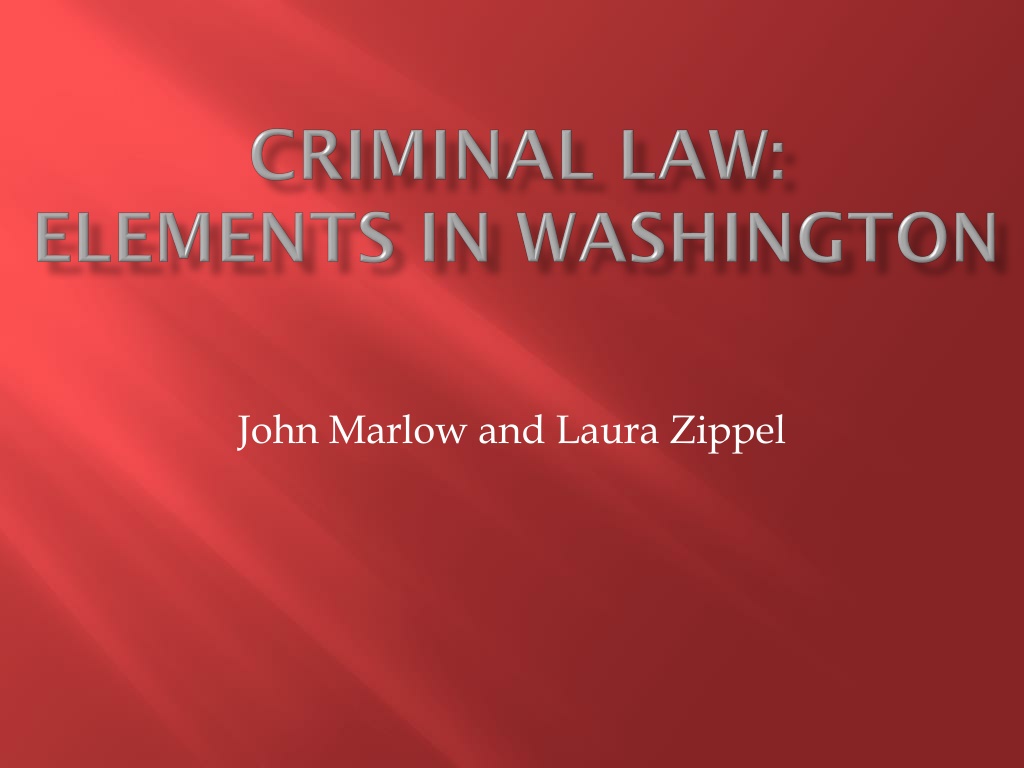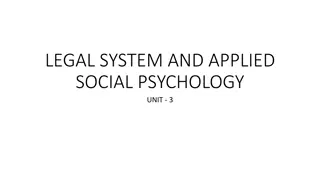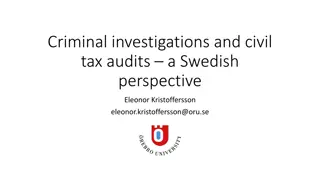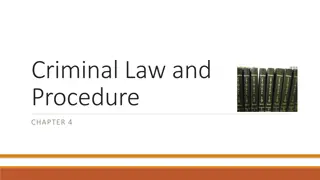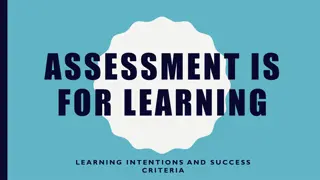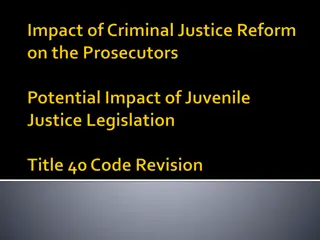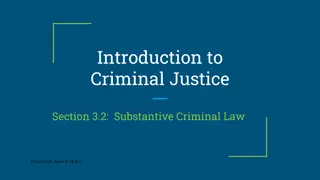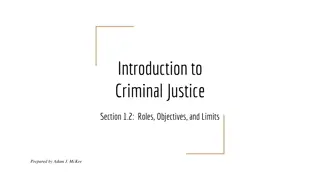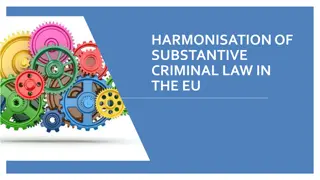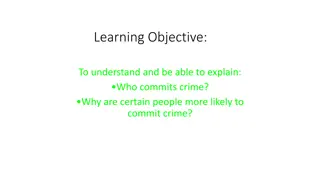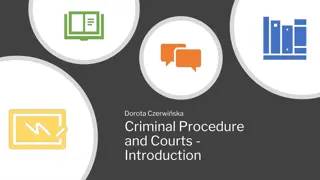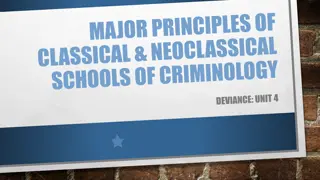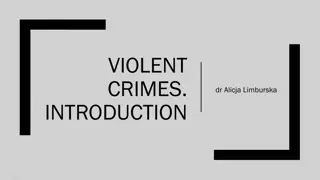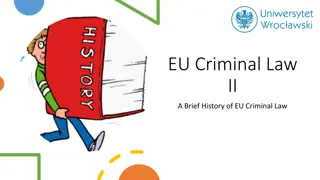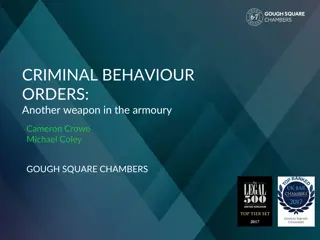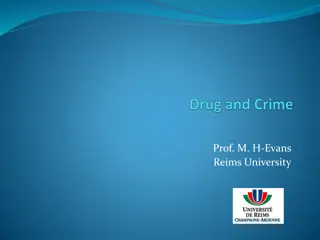Understanding Criminal Elements and Intentions in State Laws
The prosecution needs to prove all elements of a crime beyond a reasonable doubt, including Mens Rea (mental intent) and Actus Reus (criminal act). Each state has its laws defining specific crime elements, sentences, and degrees of seriousness. Examples include arson, assault with intent, and unlawful entry. Understanding these legal aspects is crucial in interpreting and applying criminal laws effectively.
Download Presentation

Please find below an Image/Link to download the presentation.
The content on the website is provided AS IS for your information and personal use only. It may not be sold, licensed, or shared on other websites without obtaining consent from the author. Download presentation by click this link. If you encounter any issues during the download, it is possible that the publisher has removed the file from their server.
E N D
Presentation Transcript
Prosecution has to prove ALL the elements of that crime. The level of proof that is required is BEYOND A REASONABLE DOUBT. Most criminal laws require that the accused had some level of INTENTION (purpose, knowledge, or recklessness) to commit the crime. This MENTAL element is called the Mens Rea. (On the following slides the Mens Rea element will be highlighted in Yellow) All crimes require an Actus Reus as well. That is, a criminal act requires some act or omission of an act on the part of the defendant. (On the following slides the Actus Reus elements will be left in White)
Each state has its own laws that define the specific elements, sentences, defenses, etc. for EACH crime. Many crimes are divided into different degrees These represent levels of seriousness based on the particular circumstances of that crime. For example: In Washington, a robbery will become First Degree Robbery if it involves (a) a deadly weapon, (b) a display of what appears to be a deadly weapon, or (c) the infliction or bodily injury.
ELEMENTS: Knowingly AND maliciously causing a fire or explosion Which is manifestly dangerous to any human life; OR which damages a dwelling; OR in any building in which there is at the time a human being who is not a participant in the crime; OR on property valued at $10,000.00 or more with the intent to collect insurance proceeds. NOTES: Dwelling means any building or structure that is occupied or is designed or intended for occupancy as a residence. RCW 49.60.040.
ELEMENTS: A person acts with intent to inflict great bodily harm and either: Assaults another with a deadly weapon or by force likely to produce great bodily harm; OR Administers, exposes, or transmits to another person, or causes another person to take poison, the human immunodeficiency virus (HIV), or any other destructive substance; OR Assaults another and inflicts great bodily harm. NOTES Under RCW 9A.36 assault basically means to cause physical harm.
ELEMENTS: A person enters or remains in a building, other than a vehicle or a dwelling; With intent to commit a crime against a person or property within; And while entering or fleeing, he or she (or another participant in the crime) is armed with a deadly weapon OR assaults any person NOTES: Under RCW 9A.36 assault basically means to cause physical harm.
Broadly, the killing of a human being by the act or omission of another, with death occurring at any time. Washington establishes five classifications of homicide. For Example: Murder (1stand 2ndDegree) Manslaughter (1stand 2ndDegree) NOTES: Omission is defined as not including or doing something (Merriam-Webster Dictionary 2014).
ELEMENTS: (Three Separate Ways to Commit) (ONE) Killing with premeditated intent; OR (TWO) Causing a death by conduct which creates a grave risk of death, under circumstances manifesting an extreme indifference to human life; OR (THREE) Killing in the course of and in furtherance of or in immediate flight from committing or attempting to commit another 1stor 2nddegree felony: The victim cannot be a participant in any of these felonies (NO MENS REA REQUIREMENT HERE) NOTES: Premeditate: consideration or planning of an act beforehand (Merriam-Webster Dictionary 2014). RCW 9A.32.020: Premeditation must involve more than a moment in point of time.
ELEMENTS: Recklessly Causing a death NOTES: A reckless person is aware of and disregards a substantial risk that harm will result. If a motor vehicle is involved, the crime is vehicular homicide under RCW 46.61.520.
ELEMENTS: A person, acting with intent to engage in conduct that would constitute a crime, Agrees with someone else to engage in or cause that conduct. One of the conspirators must then take a substantial step to further the agreement NOTES: RCW 69.50.407 indicates that the maximum punishment for conspiracy can be set as the same for underlying offense. REMEMBER: None of the elements for a conspiracy require that the crime ACTUALLY be carried out, just that the agreement AND a substantial step to do so occur.
The Buzz in the Seattle underground is that something big has just gone down. A HORRIBLE crime has just happened and all the Seattle Mob Bosses are talking about it. However, the police have not caught on. One thing is for sure though: None of the Bosses wants to get blamed when the police figure things out. Here is where you come in! Your team members and you are all part of a private investigator firm that is highly competitive with other firms in the Seattle area. Your firm prides itself on being able to find anyone or solve any case before anyone else. Each of your firms has been approached by a different Mob Boss who wants you to get all the information on this crime first so they can go to the police and see if they can clear their own name and get on the Fuzz s good side (or use the information as leverage).
Draw your confidential client cards and share them ONLY amongst your team members. These cards will include: Mob Boss Card: The mobster who has offered you a handsome fee. They will provide you with their alibi, showing that they could not have committed the mystery crime. Neighborhood Information Card: Your client has eyes around certain neighborhoods and can offer some special information what has been happening in one of those neighborhoods. Crime Tipster Cards: Anonymous tipsters can help supply information about crimes that helps to narrow the investigation. Your Mob Boss has supplied you with two such tips (Either the Actus Reus or Mens Reus elements of a crime).
The moderators have the confidential case file which contains the ACTUAL identity of the responsible Mob Boss, the exact crime, and the location where it took place with them. THAT means all the game cards that have been distributed to the various teams indicate the persons, locations, and crimes that are NOT part of the solution to this mystery case. As you gain information each round based on your own cards AND tips you learn from other teams, you should cross those answers out on your Game Sheet. The first team to completely narrow down the possible suspects, neighborhood, and crime brings their worksheet to the moderator. If they have ALL the information correct, the moderator will end the game. If not, the moderators will not say anything and continue the rounds. Each individual on a team should be assigned BEFORE the investigation starts to go undercover and infiltrate one of the competing Private Eye Firms.
Each round teams send 1 member to meet up with his or her assigned undercover firm (starting with the nearest moving clockwise around the room). The rest of the team remains. While undercover the informant member makes a guess about the solution to the game that includes 3 PIECES of information. Each piece of info can be EITHER (1) who they think committed the crime, OR (2) where the crime was committed, OR (3) which crime was committed (CONSIDER CONSPIRACY SEPARATELY from the underlying crime). Guesses do not need to include one of each of these and can include any variation of the three. If the responding firm has a card with information about ANY part of the undercover member s guess, they MUST quietly SHOW that individual 1 of the cards. The firm needs to ONLY show the undercover person 1 card. If the firm possesses NO information about any of the guesses, they only need to say Sorry, we don t have that information. The informant then returns to their team updates their worksheets.
After everyone has had the chance to be an informant and returned to their own firm, the moderators will quickly ask the class a trivia question based on past StreetLaw lessons. The first team to raise their hand and provide a CORRECT answer will get to see one of the extra game cards that the moderators are holding. After the trivia question, the next round will start and the Private Eye firms will send off their next informant. TEAMS WILL NOW DRAW THEIR GAME CARDS. Each person has a game worksheet by now and each group should discuss their strategies and game cards prior to starting. Each person should be independently filling out their worksheet as the rounds progress and MAKING SURE THAT OTHER FIRMS DO NOT SEE THAT INFORMATION WHILE MOVING AROUND.
http://www.youtube.com/watch?v=xz4- aEGvqQM Quickly strategize and wait for the moderator to start the first round.
